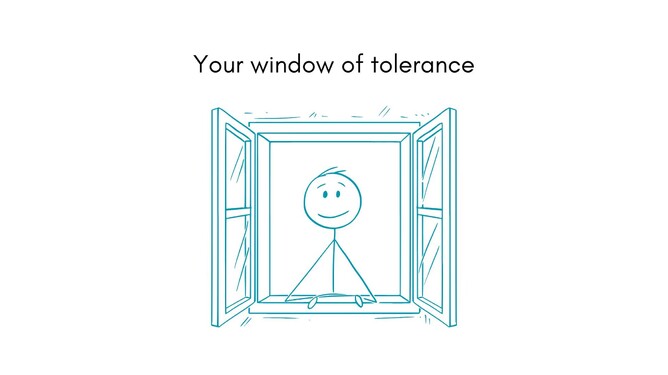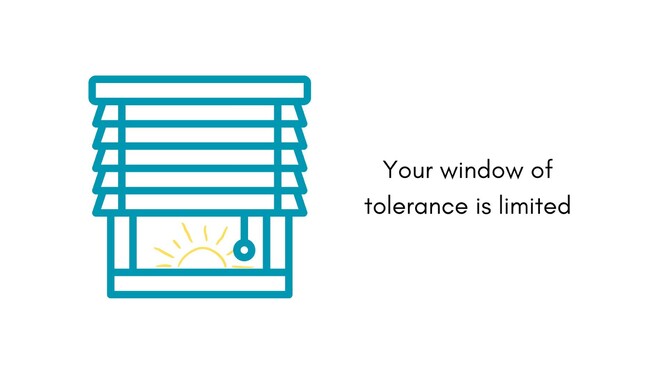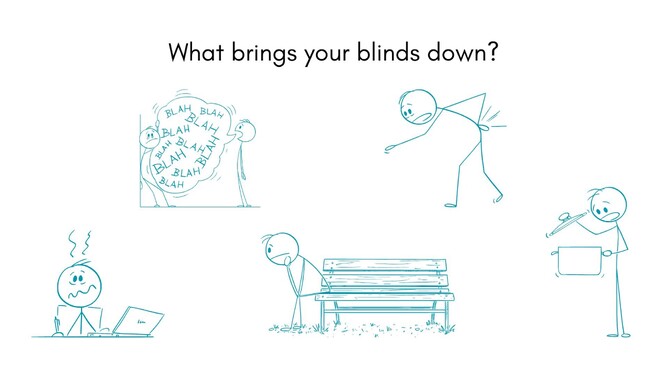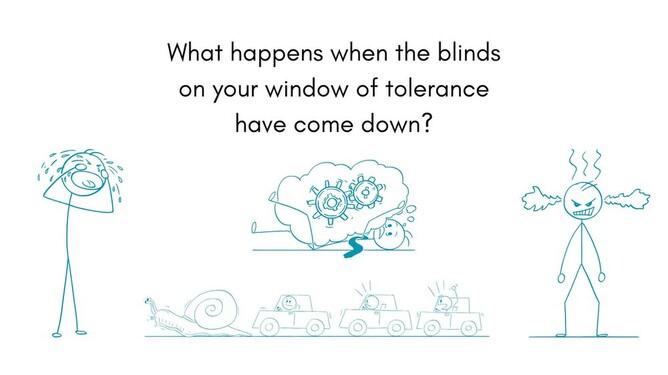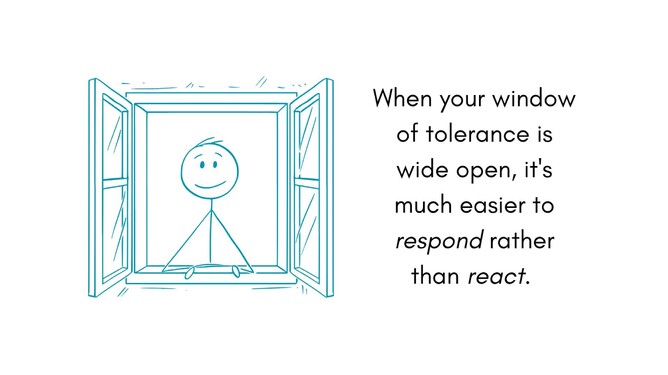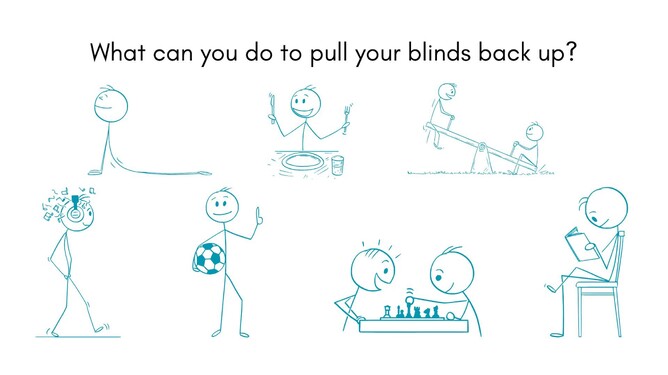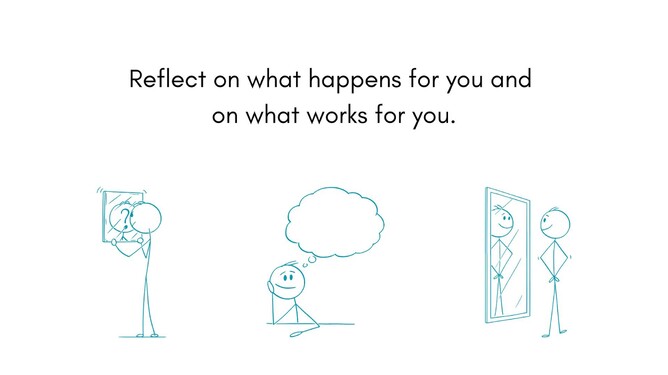It’s usually something small. Something that normally wouldn’t bother you. But all of a sudden that small thing pushes you over the edge. Maybe you forgot to buy milk at the supermarket. The one thing you went there for in the first place. Maybe you missed the bus to work. Maybe you dropped and broke a glass. Maybe your flight was cancelled. Maybe you stubbed your toe. Or maybe you are gutted that you can’t hang out with your friends tonight.
All little things. All things that are a little annoying or frustrating or sad, but not devastating. And yet, sometimes it is precisely those little things that push us too far. They are the straw that breaks the camel’s back, to use just another metaphor.
What really happens here is that you have exhausted your window of tolerance. The term was first used by Dan Siegel^. It is a useful concept to help us understand why we sometimes respond to things fine and why, at other times, we find ourselves pushed into over- or underreactions.
There are different ways of explaining the window of tolerance. I find it most helpful to picture it as a window with the blinds pulled up and daylight streaming in. When something happens that is a bit inconvenient, upsetting, frustrating, painful, etc. the blinds come down a little, and we have less light coming through the window. Most of the time we can still choose our response because we still have enough light coming in, we can put things in perspective, we can see reasonably clearly and we can make rational decisions on how to act. But…
Your window of tolerance is finite.
This means, there is only so much you have tolerance for, and once you go past your capacity, you find yourself reacting more than you are responding. And that can understandably add further frustration and upset to the already difficult situation
There are a few other things that can bring your blinds down too: a lack of sleep or feeling generally tired or exhausted, feeling angry, being hungry, … even worse if you are hangry…, experiencing pain, too much caffeine, drugs & alcohol, but also past experiences or ongoing frustrations with someone or something.
I’ll give you a little example: Say you get to the airport early in the morning, check in your bag and wait at the gate. All of a sudden, you hear the announcement, ‘Ladies & Gentlemen, Flight XYZ to Paradise is cancelled, please make your way to the baggage claim to uplift your bags and check the app or the airline counter to see what your options are.’ While this is a little annoying and will cost you a bit of time, you may not need to get upset about it. You follow the instructions and you sort another flight. All is well.
Now imagine the same situation, but you arrive at the airport exhausted, because you have hardly slept the night before and you have had a busy week. You have had to run from the car to check in to make sure you dropped your bag in time. Then, finally, close to the gate, you buy a coffee to help you start the day and in a moment of inattention you spill the coffee. Some of it drips on your shirt. You are already gutted and frustrated before you even hear the announcement, ‘Ladies & Gentleman, flight XYZ…’ and so on. In this scenario, you all of a sudden find yourself in tears, yelling at staff, or having a go at a loved one on the phone to air your frustration or upset. You might think, ‘Why me?’, ‘Why always me?’, ‘This is a shit week.’, ‘Everything is going wrong.’, etc.
Notice how the same announcement can prompt quite different responses or reactions. In the second example, your exhaustion, lack of sleep, the rush, and the spilt coffee have already brought your blinds down so far that the cancelled flight is too much. You’ve gone over the limit of your window of tolerance. In contrast, when you experience the same situation well-rested, calm, and without coffee spillage, you are much more likely to respond to the frustration in a more relaxed fashion.
Watch this short clip to see what might contribute to your blinds coming down...
The key difference is that with your window of tolerance wide open, you can choose a response. With the blinds down, you are likely to simply react, rather than respond. Of course, this also happens when bigger issues are going on, e.g. when you have a relative in hospital and you are worried about them, when you are injured and in pain, when you are worried about money, when you have just lost a pet, etc. all those experiences also bring your blinds down. And you might be able to manage, just, with all that is going on, and then a small thing comes along, like you accidentally put pepper on your food instead of salt… and that’s that. Your blinds are down.
When the blinds are down, we might cry more easily, we might get angry more easily, perhaps we yell more, and you are more likely to want to bang doors and beep your horn in traffic. We often think that our reaction in those situations is a more visible expression of emotions, e.g. snapping, crying, yelling, outright frustration, and sadness. This is true if our brain is engaged in a fight or flight response to the stress, which engages the sympathetic nervous system and temporarily disconnects the prefrontal cortex, which usually allows us to think rationally, take perspective, reason, etc. Without the prefrontal cortex, we struggle to regulate our emotions and we also can’t see the big picture which makes it difficult to put things in perspective.
But we can go in the other direction, too. Sometimes the blinds come down and our brain goes into a freeze response, which means the parasympathetic nervous system is engaged. We shut down and we withdraw, we get very quiet, we don’t say much and we don’t show much emotion at all because we feel overwhelmed.
All of those reactions and responses are normal. Emotions are normal. And the fact that we react to stress is normal. Our ability to regulate emotions depends on a few things, including our emotional awareness, our emotion regulation skill set and the state of our window of tolerance. Everyone’s window of tolerance is different. This means it is important you get to know yours.
So, what can you do to keep your window of tolerance wide open, the blinds up, and yourself ultimately in a position to choose your response, rather than react to what happens?
First of all, pay attention.
Notice how you are feeling and what you are feeling. See if you can check in with yourself around some of your basic needs, e.g. have you had enough water, food, sleep, movement, connection with others, etc. This is a useful check-in to do regularly as a lack of those things brings your blinds down. So a bit of self-awareness and awareness of how you are feeling is the first step.
Then, notice and reflect on what regularly brings your blinds down, what frustrates you, makes you sad, angers you, and upsets you. The goal is not to avoid those things entirely, but rather to anticipate that they might (well, likely will) happen, and to be prepared for that. Because in life there is a bit of up and down; we might as well accept that. For example, not eating and not moving enough usually makes me both restless and hangry. If I know that, I can make sure I do something about that before I go into rush hour traffic, to the supermarket or clean the flat, things that regularly annoy me.
The next thing to notice and reflect on is what helps you bring your blinds back up. For me that is time with friends, good conversations, various forms of exercise, listening to music, writing, jumping in the sea, etc. You know yourself best. What helps you pull your blinds back up?
The tricky bit is to notice that your window of tolerance is getting smaller, that you are getting closer and closer to only having a slither of lights coming through at the bottom of the blinds before it is too late. Ideally, you pull your blinds back up at that point. Don’t wait until after you’ve snapped or shut down.
This takes practice.
You won’t get it ‘right’ every time.
There is no real getting this ‘right’, anyway because those emotions are normal and they are useful in giving you information on the fact that it’s all a bit much at the moment. So, they are kind of doing their job… It’s just that they have probably been trying to alert you for a little while now, they have been trying to get your attention, and once the blinds are fully down, they just show up slightly more powerfully and with slightly more force.
So, practise!
Practise noticing your emotions and your window of tolerance.
Practice checking in on where your blinds are, what is currently bringing them down and what will help you pull them up.
Practise lots.
As we are coming to the end of the year, many of us are trying to get the last bits of work done and we are busy organising presents, events or gatherings. Maybe as you prepare for Christmas, you feel a little less calm, a little less patient and a little less relaxed. Pay attention to that, because that is probably an indication that your blinds are coming down.
Make time to rest, relax, reflect and recharge for a few minutes. Do something that will pull your blinds back up.
Perhaps it would be useful to also acknowledge that we seem to have a different range of tolerance for certain things or certain people. So if you are still frustrated about something someone did the last time you two interacted, chances are the blinds are halfway down in your interactions with that person. If being stuck in traffic is particularly annoying for you, the holiday season may be a time when your window of tolerance will be tested. You can anticipate those things. And you can prepare.
Think about how you would like to respond. And think about how you can build in little opportunities to pull your blinds back up.
Don’t worry, though. You are not the only one. We all have windows of tolerance.
And all our blinds are constantly going up and down depending on what is happening.
The best place to start is to get to know your window, what brings your blinds down and what helps you to pull them up. Start there and communicate what you need to keep your blinds up with those around you.
If you have found this useful or it has made you think, please let me know. I would love to hear from you. Send me a message on Instagram @mankertina. And if you know someone who might find this useful, please share it with them.
Key points:
Our window of tolerance is limited and everyone’s window of tolerance is different.
When the blinds are fully down, we tend to react rather than choose a response.
Self-awareness helps you identify what brings your blinds down and what helps you pull them back up to keep the window wide open.
Reflective Questions:
When have you experienced a situation when your blinds were fully down, when something small pushed you too far, when you simply reacted?
What are common things or behaviours & interactions with people that bring your blinds down?
What are activities you can do and actions you can take regularly to keep your blinds up and your window of tolerance wide open?
Bonus: Are there particular people who bring the blinds of your window down more quickly? Who are they and why are you less patient/tolerant with them? What can you try to keep your window of tolerance open for longer next time you see them?
^ If you are curious, read more here: The Developing Mind: Toward a Neurobiology of Interpersonal Experience by Daniel J. Siegel, Guilford Press, 1999
